From Israel Post. These stamps will be issued December 19, 2017. Larger image below.
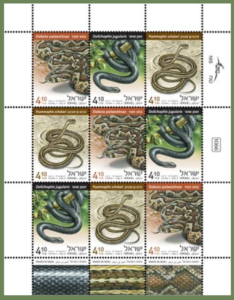 Israel is home to many different reptile species thanks to its location at the meeting point of three different continents and the wealth of habitats it provides. Some 100 reptile species make their homes here, among them approximately 40 species of snakes, nine of which are venomous.
Israel is home to many different reptile species thanks to its location at the meeting point of three different continents and the wealth of habitats it provides. Some 100 reptile species make their homes here, among them approximately 40 species of snakes, nine of which are venomous.
Snakes are an important component in ecological systems and in the food chain of predators and prey. They feed on arthropods, fish, fowl, small mammals and other reptiles, including snakes, each species according to its size and abilities. Snakes are preyed upon by birds, hedgehogs, mongooses and other animals.
Snakes also face other dangers – dwindling numbers of habitats, accidents with vehicles on the roads and agricultural equipment in the fields, as well as intentional harm by humans. All the snakes and other reptile species in Israel are protected by law and it is illegal to harm them. It is imperative that they are kept safe, as part of ensuring healthy ecological systems.
Schokari Sand Racer (Psammophis schokari)
Length: to 120 cm
This is a rear fanged snake, i.e. it has venomous back teeth. The venom is not injected by a quick bite but rather through a prolonged bite. Like the other sub venomous snakes found in Israel, the Schokari Sand Racer is not hazardous to humans. It is thin and fast and has a number of different attributes: in the northern and central areas of the country it most commonly has four dark lengthwise stripes against a brownish-yellow background whereas the snakes in the south have faded lengthwise stripes or none at all. There is a dark stripe along the sides of the head, beside the eyes. This is one of the only snake species in Israel that can be found throughout the entire country, from Mt. Hermon in the north to Eilat in the south. It is common in different habitats, climbs on shrubs, walls, etc. It feeds on a wide range of animals: arthropods, reptiles, birds and small rodents.
Large Whip Snake (Dolichophis jugularis)
Length: to 250 cm
The Large Whip Snake is not venomous. It is large and shiny and its appearance changes when it reaches maturity. When young, this snake is brown or grey with black and white spots. The mature snake (usually more than 120 cm in length) is completely black. In both instances, the shade of the lower jaw is lighter than the body. It feeds on different animals: reptiles, birds, rodents and more. These snakes are commonly found in agricultural areas, where their food supply is abundant, thus they are frequently killed by farming equipment. Found from Mt. Hermon in the north to the Beer Sheva area in the south.
Palestine Viper (Daboia palaestinae)
Length: to 135 cm
The Viper is venomous and the most dangerous to humans of all the snake species found in Israel, due to the potency and quantity of its venom, as well as its prevalence in inhabited areas. Its background color is yellowish, light brown or grey, with a lengthwise zigzag stripe that is brown with dark edges. Sometimes this stripe appears broken. There are additional spots on the sides of the body. This snake’s head is significantly wider than its neck and it has small scales. It is common in various habitats (including sand) in the Mediterranean region, from Mt. Hermon in the north to the Beer Sheva area in the south. It is prevalent around agricultural communities, where it is attracted to the rodents found in chicken coops, storerooms, cowsheds, etc. This Viper is responsible for the vast majority of cases in which humans are bitten in Israel. Hospitals have an antidote for its venom, which is given to the injured as needed.
Rules of Caution
In the field: high-top shoes are recommended; do not stick one’s hand into concealed places (day or night); shake out equipment and shoes after spending the night outdoors. In inhabited areas: avoid piles of pruned branches, scrap-iron, stones, etc. Keep the area clear of food scraps that attract rodents.
If You See a Snake
In the field: allow the snake to find its way by itself. Do not approach it or try to trap it. At home or in the yard: call a trained snake catcher. Keep children and animals away from the snake and try to keep it in sight until the catcher arrives. A list of licensed snake catchers is posted on the Israel Nature and Parks Authority website. Some local authorities also provide snake catching services.
First Aid in Case of Snakebite
What to do: calm the injured person, lie them down and take them to the hospital (even if he/she feels well). If the bite is on the arm or leg, it is possible to put a splint on the limb (like in the case of a fracture). Remove any rings, bracelets, watch, etc. from the injured person. If possible, take a photo of the snake.
What not to do: do not cut or burn or suck the bitten area. Do not block the blood vessels with a tourniquet. Do not put ice on the bite site, do not sterilize the spot with alcohol, do not let the injured person drink hot liquids or alcohol. Do not try to catch the snake. These guidelines do not replace medical consultation and treatment.
— Noam Kirshenbaum
Editor and Publisher, Nature in Israel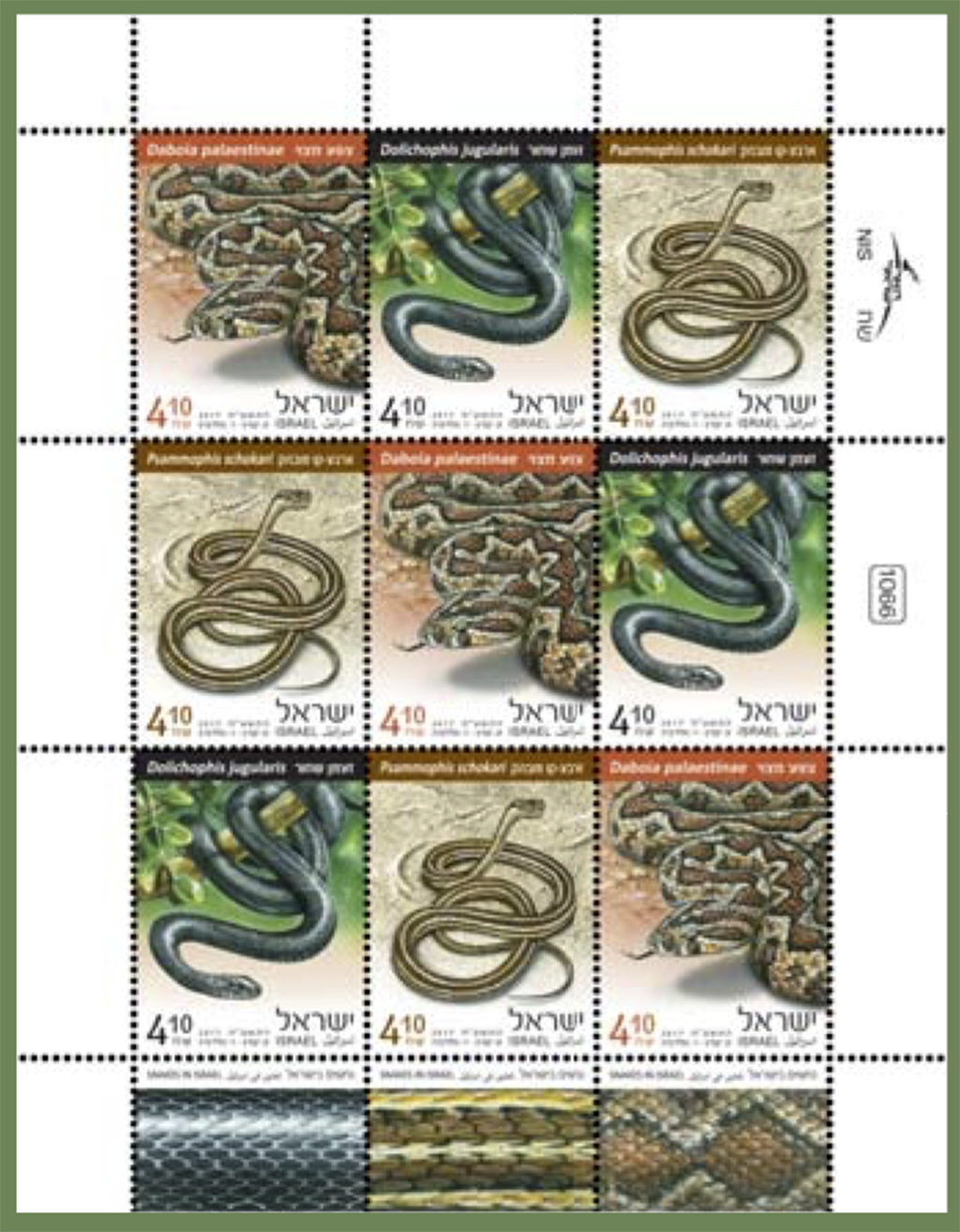
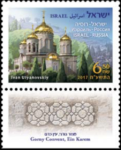 The magnificent gold –domed Russian church named the Gorny Convent in Jerusalem was chosen as the topic for the Joint Issue with Russia. The church represents Russia’s deep religious bond to Jerusalem and the joint issue expresses Russia’s friendship with Israel.
The magnificent gold –domed Russian church named the Gorny Convent in Jerusalem was chosen as the topic for the Joint Issue with Russia. The church represents Russia’s deep religious bond to Jerusalem and the joint issue expresses Russia’s friendship with Israel.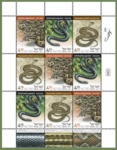 Some people scream and others have them as pets but Snakes are first and foremost an important component in the food chain of predators and prey. Although no one wants to get bitten by a snake, it is imperative that they are kept safe as part of ensuring healthy ecological systems.
Some people scream and others have them as pets but Snakes are first and foremost an important component in the food chain of predators and prey. Although no one wants to get bitten by a snake, it is imperative that they are kept safe as part of ensuring healthy ecological systems. Submarines are an important part of any navy and this stamp set shows the history of the submarines acquired by Israel’s Navy. Today, interestingly, some of the most innovative parts of the new sophisticated submarines are manufactured in Israel.
Submarines are an important part of any navy and this stamp set shows the history of the submarines acquired by Israel’s Navy. Today, interestingly, some of the most innovative parts of the new sophisticated submarines are manufactured in Israel. Today, when you visit one of the Ancient Roman Arenas represented on this stamp set you can close your eyes and imagine the noise, the atmosphere, the cheering on, bloody shows, gladiators and chariot races. All this is depicted on the stamps which represent three types of Roman arenas that are found in Israel: theater, amphitheater and hippodrome.
Today, when you visit one of the Ancient Roman Arenas represented on this stamp set you can close your eyes and imagine the noise, the atmosphere, the cheering on, bloody shows, gladiators and chariot races. All this is depicted on the stamps which represent three types of Roman arenas that are found in Israel: theater, amphitheater and hippodrome. Israel recognizes the importance of Integrating People with Disabilities in Society and promoting their increased involvement in the life of the country, not only as those who receive but also as those that want to contribute and share their talents with society.
Israel recognizes the importance of Integrating People with Disabilities in Society and promoting their increased involvement in the life of the country, not only as those who receive but also as those that want to contribute and share their talents with society.
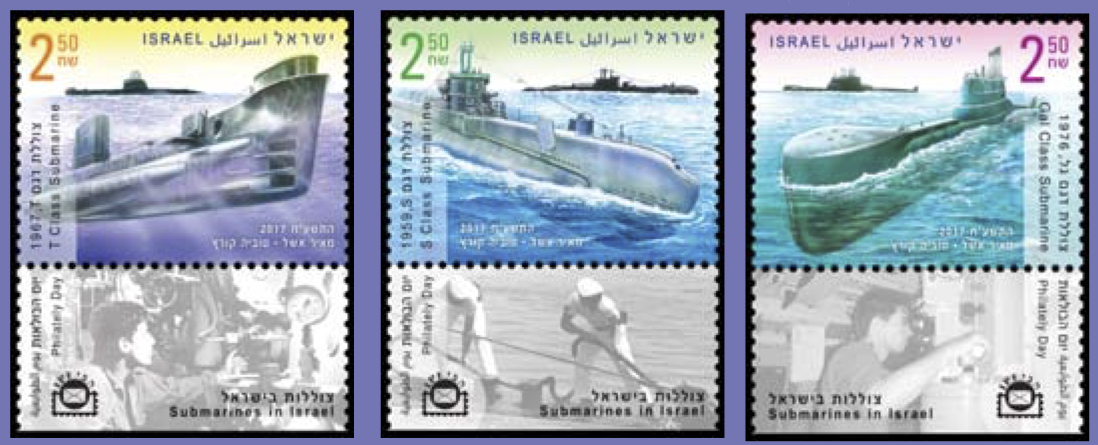 The Israeli Navy did not have any submarines when it was founded in March 1948. The thought of acquiring and operating submarines did not ripen until a few years later. It was a bold and innovative step for the teams slated to operate these submarines as well as the technical personnel who would maintain them. Submarine personnel are selected meticulously, as they must be extremely level-headed and professional, and beyond all else must be able to work and live as a team.
The Israeli Navy did not have any submarines when it was founded in March 1948. The thought of acquiring and operating submarines did not ripen until a few years later. It was a bold and innovative step for the teams slated to operate these submarines as well as the technical personnel who would maintain them. Submarine personnel are selected meticulously, as they must be extremely level-headed and professional, and beyond all else must be able to work and live as a team. Israel is home to many different reptile species thanks to its location at the meeting point of three different continents and the wealth of habitats it provides. Some 100 reptile species make their homes here, among them approximately 40 species of snakes, nine of which are venomous.
Israel is home to many different reptile species thanks to its location at the meeting point of three different continents and the wealth of habitats it provides. Some 100 reptile species make their homes here, among them approximately 40 species of snakes, nine of which are venomous.
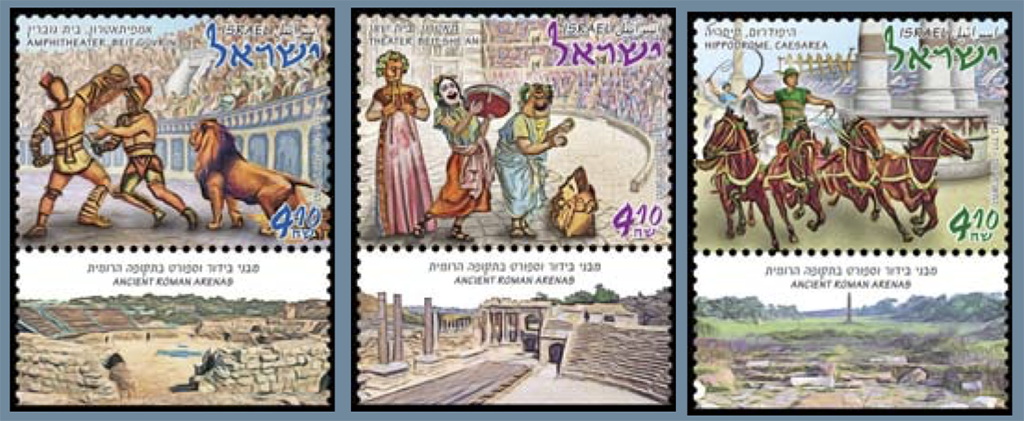
 From Israel Post. This stamp will be issued December 19, 2017.
From Israel Post. This stamp will be issued December 19, 2017. This stamp will be issued December 19, 2017. From Israel Post:
This stamp will be issued December 19, 2017. From Israel Post: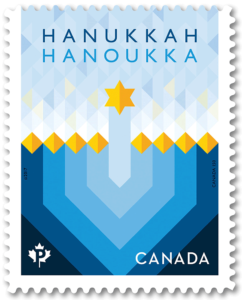 What was the design change that caused the delay in sale of the stamp, as announced in the press release immediately below?
What was the design change that caused the delay in sale of the stamp, as announced in the press release immediately below? HALIFAX – Canada Post issued a stamp November 6, 2017, commemorating the devastating explosion that rocked Halifax on the morning of December 6, 1917, when two ships – one loaded with explosives – collided in the narrows leading to its harbour. Released one month before the 100th anniversary of that fateful day, the issue also salutes the resilience of the Haligonians who rebuilt their city from the ashes.
HALIFAX – Canada Post issued a stamp November 6, 2017, commemorating the devastating explosion that rocked Halifax on the morning of December 6, 1917, when two ships – one loaded with explosives – collided in the narrows leading to its harbour. Released one month before the 100th anniversary of that fateful day, the issue also salutes the resilience of the Haligonians who rebuilt their city from the ashes.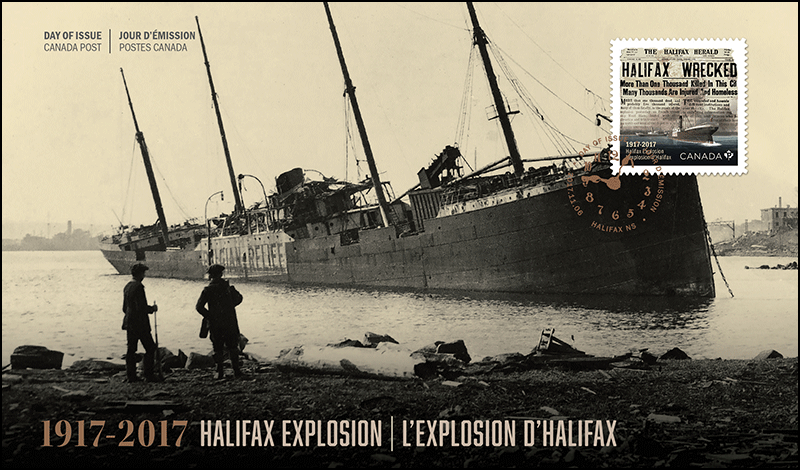 Halifax was a bustling port supplying Canada’s efforts in the First World War in 1917. The blast occurred when a fire detonated munitions aboard the French ship Mont-Blanc after it struck the Imo, a Norwegian cargo ship. The largest human-made explosion in history, prior to the detonation of the first atomic bomb. It claimed the lives of nearly 2,000 people, injured 9,000 more, and damaged property worth millions of dollars.
Halifax was a bustling port supplying Canada’s efforts in the First World War in 1917. The blast occurred when a fire detonated munitions aboard the French ship Mont-Blanc after it struck the Imo, a Norwegian cargo ship. The largest human-made explosion in history, prior to the detonation of the first atomic bomb. It claimed the lives of nearly 2,000 people, injured 9,000 more, and damaged property worth millions of dollars.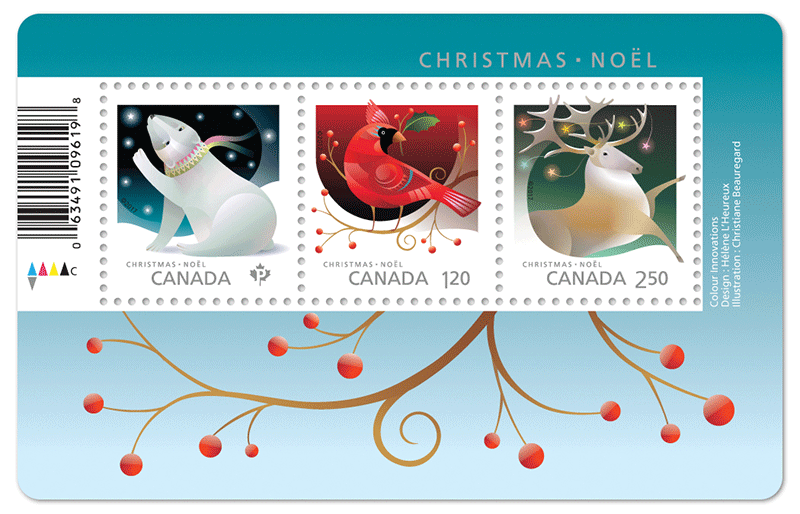
 OTTAWA – Since 1964, Canadians have counted on Canada Post to dress up their holiday mail with festive stamps heralding the season. Christmas stamps have become a tradition dear to our hearts – and a joyful sign that the holidays are almost upon us. Once again this year, Canadians can make their mail merrier with their choice of stamps bearing either sacred or secular imagery.
OTTAWA – Since 1964, Canadians have counted on Canada Post to dress up their holiday mail with festive stamps heralding the season. Christmas stamps have become a tradition dear to our hearts – and a joyful sign that the holidays are almost upon us. Once again this year, Canadians can make their mail merrier with their choice of stamps bearing either sacred or secular imagery.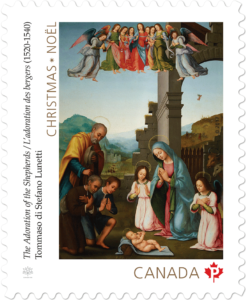 This year’s sacred issue, designed by Louise Méthé, showcases The Adoration of the Shepherds, a vibrant oil-on-panel painting housed at the Art Gallery of Ontario. Attributed to Italian artist Tommaso di Stefano Lunetti (c. 1495-1564), this carefully composed masterpiece was based on Luke’s gospel, in which angels announced the birth of Jesus to shepherds, who then rushed from their fields to find their newborn saviour.
This year’s sacred issue, designed by Louise Méthé, showcases The Adoration of the Shepherds, a vibrant oil-on-panel painting housed at the Art Gallery of Ontario. Attributed to Italian artist Tommaso di Stefano Lunetti (c. 1495-1564), this carefully composed masterpiece was based on Luke’s gospel, in which angels announced the birth of Jesus to shepherds, who then rushed from their fields to find their newborn saviour.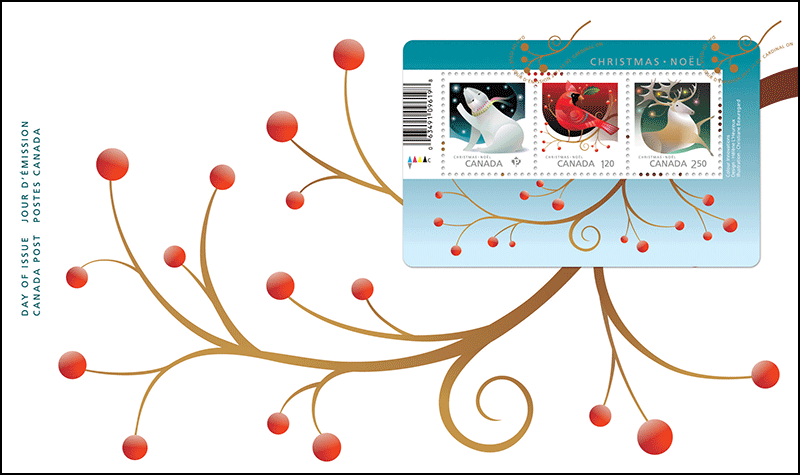
 OTTAWA – Depuis 1964, les Canadiens comptent sur Postes Canada pour orner leur courrier des Fêtes de jolis timbres aux motifs symboliques. Cette tradition a séduit nos cœurs et les vignettes sont un rappel agréable de l’arrivée de Noël. Cette année encore, nous pouvons égayer nos envois de timbres consacrés à des thèmes religieux ou profane.
OTTAWA – Depuis 1964, les Canadiens comptent sur Postes Canada pour orner leur courrier des Fêtes de jolis timbres aux motifs symboliques. Cette tradition a séduit nos cœurs et les vignettes sont un rappel agréable de l’arrivée de Noël. Cette année encore, nous pouvons égayer nos envois de timbres consacrés à des thèmes religieux ou profane.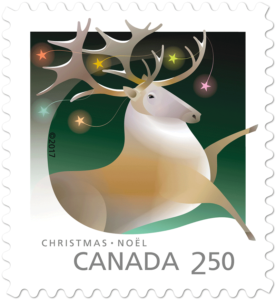 la rencontre de leur jeune sauveur.
la rencontre de leur jeune sauveur.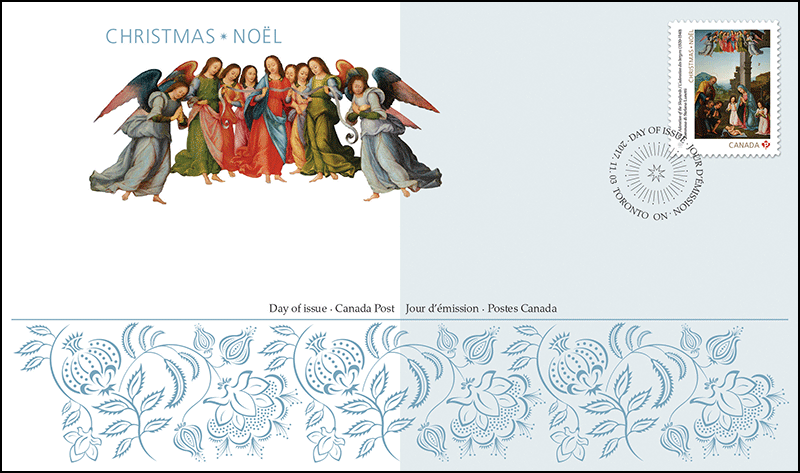
 TORONTO – For the first time ever, Canada Post has adhered a miniature fabric crest to a stamp – to mark the 100th year anniversary of the Toronto Maple Leafs, one of the most storied teams in the National Hockey League®. The commemorative issue also includes both a booklet of 10 new silver logo stamps and a coil of 50 puck-shaped stamps in Maple Leaf blue.
TORONTO – For the first time ever, Canada Post has adhered a miniature fabric crest to a stamp – to mark the 100th year anniversary of the Toronto Maple Leafs, one of the most storied teams in the National Hockey League®. The commemorative issue also includes both a booklet of 10 new silver logo stamps and a coil of 50 puck-shaped stamps in Maple Leaf blue. be the golden era of hockey. It has more inductees in the players’ category of the Hockey Hall of Fame than any other Original Six™ team, and is among the most valuable franchises in the NHL.
be the golden era of hockey. It has more inductees in the players’ category of the Hockey Hall of Fame than any other Original Six™ team, and is among the most valuable franchises in the NHL. The special fabric crest stamp (right), available only as a commemorative souvenir sheet, depicts the sweater worn by Maple Leafs captain Ted (Teeder) Kennedy during the 1949-50 NHL season, with the Leafs crest in fabric. Kennedy played centre for the Leafs between 1942-43 and 1956-57, captaining the team for eight years. He remains the youngest ever to suit up for the Leafs (he was 17) and the first, along with teammate Turk Broda, to win five Stanley Cup® Championships.
The special fabric crest stamp (right), available only as a commemorative souvenir sheet, depicts the sweater worn by Maple Leafs captain Ted (Teeder) Kennedy during the 1949-50 NHL season, with the Leafs crest in fabric. Kennedy played centre for the Leafs between 1942-43 and 1956-57, captaining the team for eight years. He remains the youngest ever to suit up for the Leafs (he was 17) and the first, along with teammate Turk Broda, to win five Stanley Cup® Championships.  Official First Day Covers (OFDCs) of all three stamps are available as a set. Stamps and related collectibles are currently available online at canadapost.ca/leafs100 or at post offices on October 24.
Official First Day Covers (OFDCs) of all three stamps are available as a set. Stamps and related collectibles are currently available online at canadapost.ca/leafs100 or at post offices on October 24.  The Toronto Maple Leafs issue was designed by Lionel Gadoury and Dave Hurds for Context Creative of Toronto.
The Toronto Maple Leafs issue was designed by Lionel Gadoury and Dave Hurds for Context Creative of Toronto.  Canada Post is proud to be Canada’s storyteller through its national stamp program. Stamps capture and tell the stories of this country’s milestones and achievers – and its heritage. Over the years, Canada Post has issued scores of stamps commemorating Canada’s national winter sport. The first hockey-themed stamp was issued on January 23, 1956.
Canada Post is proud to be Canada’s storyteller through its national stamp program. Stamps capture and tell the stories of this country’s milestones and achievers – and its heritage. Over the years, Canada Post has issued scores of stamps commemorating Canada’s national winter sport. The first hockey-themed stamp was issued on January 23, 1956. The silver logo domestic-rate stamp is available in a booklet of 10 for $8.50. A 50-stamp coil of the blue puck-shaped stamp is offered with a complementary puck-shaped dispenser. A fabric patch souvenir sheet comes in a collectible folder and sells for $5. Official First Day Covers (OFDCs) of all three stamps are available as a set for $9.70.
The silver logo domestic-rate stamp is available in a booklet of 10 for $8.50. A 50-stamp coil of the blue puck-shaped stamp is offered with a complementary puck-shaped dispenser. A fabric patch souvenir sheet comes in a collectible folder and sells for $5. Official First Day Covers (OFDCs) of all three stamps are available as a set for $9.70.
 “Toronto Maple Leafs” and associated word marks and logos are trademarks of Maple Leafs Sports & Entertainment Partnership. © 2017. All Rights Reserved.
“Toronto Maple Leafs” and associated word marks and logos are trademarks of Maple Leafs Sports & Entertainment Partnership. © 2017. All Rights Reserved.

